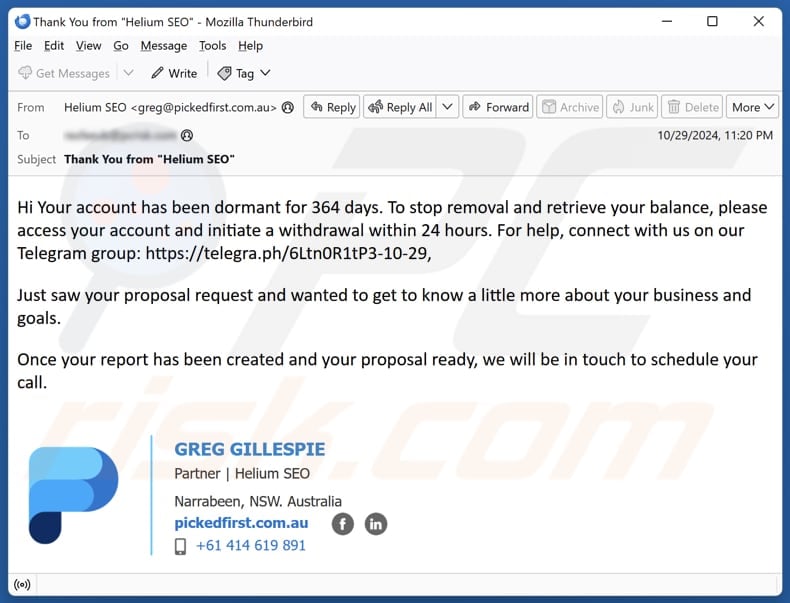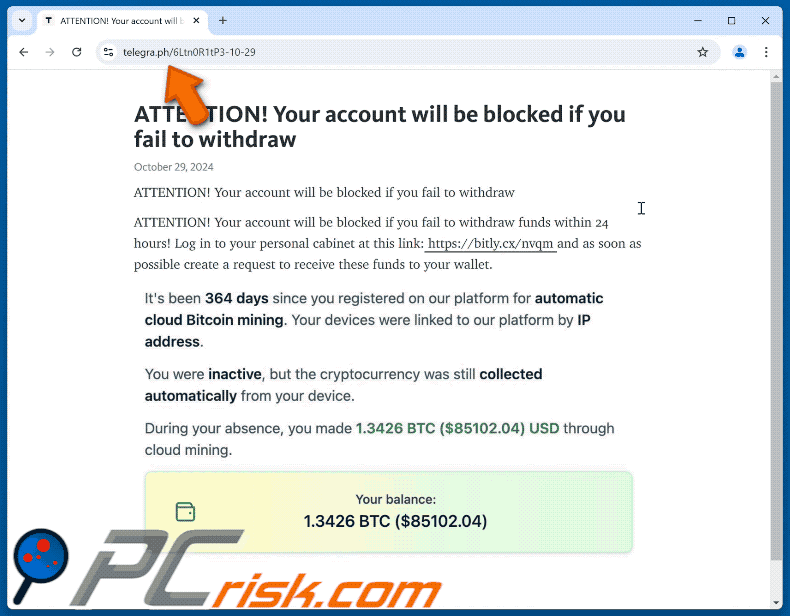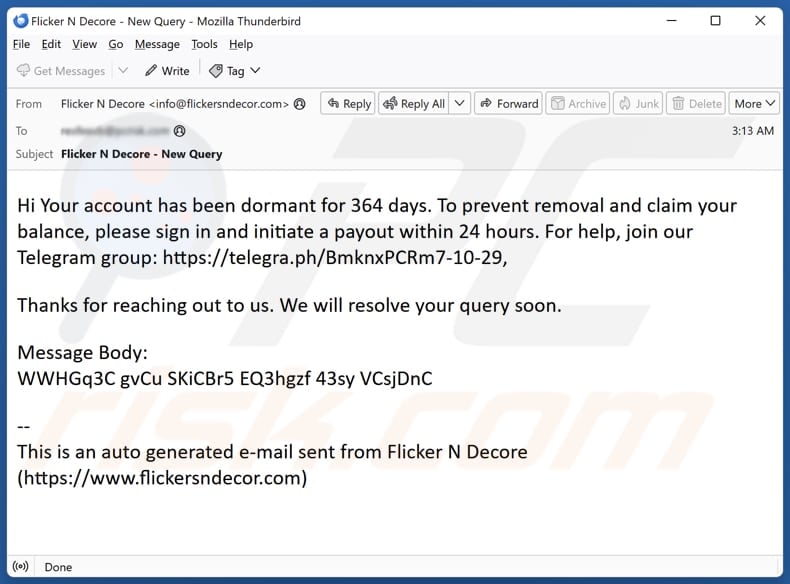How to identify scams like "Your Account Has Been Dormant"
Phishing/ScamAlso Known As: Your Account Has Been Dormant phishing campaign
Get free scan and check if your device is infected.
Remove it nowTo use full-featured product, you have to purchase a license for Combo Cleaner. Seven days free trial available. Combo Cleaner is owned and operated by RCS LT, the parent company of PCRisk.com.
What kind of scam is "Your Account Has Been Dormant"?
Our team has analysed this scam and discovered that it includes at least two similar email versions. In both cases, scammers aim to trick recipients into believing that they have to take take urgent action to resolve the "occured" issue. Their ultimate goal is to steal personal information from recipients.

More about the "Your Account Has Been Dormant" scam email
These scam emails inform the recipient that their account has been inactive for 364 days and warn that it will be deleted unless they access it and make a withdrawal within 24 hours. They urge the recipient to take immediate action to retain their account balance, providing a link to a Telegram group for assistance.
Both emails lead to identical scam websites (even though their URLs differ). These scam sites falsely claim that the visitor's account will be blocked unless they withdraw their balance of 1.3426 BTC within 24 hours. They urge the user to log in and create a withdrawal request, asserting that the visitor earned this cryptocurrency through automated cloud mining over 364 days of inactivity.
Following the instructions on these deceptive pages results in receiving a request to sign in to an account using a username and password. However, when users input their credentials, they unknowingly provide this sensitive information directly to scammers, who can then misuse it to gain unauthorized access, compromise accounts, or sell the data to other cybercriminals.
Overall, falling victim to this scam can result in monetary loss, identity theft, and other issues. It is highly advisable to examine emails before opening any links, attachments, or disclosing information.
| Name | Your Account Has Been Dormant Email Scam |
| Threat Type | Phishing, Scam, Social Engineering, Fraud |
| Fake Claim | Your crypto wallet has been dormant for 364 days |
| Related Domain | telegra[.]ph |
| Detection Names | ArcSight Threat Intelligence (Suspicious), CyRadar (Malicious), MalwareURL (Malware), Netcraft (Malicious), VIPRE (Malware), Full List Of Detections (VirusTotal) |
| Disguise | Notification from a crypto wallet service provider |
| Symptoms | Unexpected/irrelevant notification from an unknown sender. |
| Distribution methods | Deceptive emails. |
| Damage | Loss of sensitive private information, monetary loss, identity theft. |
| Malware Removal (Windows) |
To eliminate possible malware infections, scan your computer with legitimate antivirus software. Our security researchers recommend using Combo Cleaner. Download Combo CleanerTo use full-featured product, you have to purchase a license for Combo Cleaner. 7 days free trial available. Combo Cleaner is owned and operated by RCS LT, the parent company of PCRisk.com. |
Similar scam emails in general
Emails of this type are designed to deceive recipients into sharing sensitive information. They often impersonate legitimate companies, organizations, or other entities, and use urgent language to trick users into opening links or attachments. Victims of such scams usually experience identity theft, monetary loss, and (or) privacy issues.
It is important to note that fraudulent emails can be employed to trick recipients into infecting their computers. Examples of scam emails are "Payment Has Been Sent", "ZOHO Mail Interruption Notice", "Outlook - Upgraded Version Now Available".
How do spam campaigns infect computers?
Cybercriminals often use email to distribute malware. They do so by including harmful attachments or links in their messages. If a user opens an infected attachment, such as a document or executable file, it can initiate malware on the device. However, certain malicious files require further actions before they can inject malware.
For instance, malware hidden in Microsoft Office files becomes active only when users enable macros. Additionally, links within these emails may lead users to fake sites where they might be deceived into downloading malware, or the links may direct them to sites that automatically trigger malware downloads.
How to avoid installation of malware?
Download software and files from trusted sources, such as official websites and reputable app stores. Do not use other sources, and never download pirated software or cracking tools. Always scrutinize emails before opening any attachments or clicking on links, particularly if they are from unfamiliar senders or appear unexpected or irrelevant.
Avoid clicking advertisements, pop-ups, buttons, or links on dubious websites. Keep your operating system and applications up to date, and use a dependable security tool. If you have already opened malicious attachments, we recommend running a scan with Combo Cleaner Antivirus for Windows to automatically eliminate infiltrated malware.
The appearance of a scam website promoted through these emails (GIF):

Text presented in the first "Your Account Has Been Dormant" email letter:
Hi Your account has been dormant for 364 days. To stop removal and retrieve your balance, please access your account and initiate a withdrawal within 24 hours. For help, connect with us on our Telegram group: hxxps://telegra.ph/6Ltn0R1tP3-10-29,
Just saw your proposal request and wanted to get to know a little more about your business and goals.
Once your report has been created and your proposal ready, we will be in touch to schedule your call.
GREG GILLESPIE
Partner | Helium SEO
Narrabeen, NSW. Australia
pickedfirst.com.au FacebookLinkedIn
+61 414 619 891
Screenshot of the second variant:

Text in this email:
Hi Your account has been dormant for 364 days. To prevent removal and claim your balance, please sign in and initiate a payout within 24 hours. For help, join our Telegram group: hxxps://telegra.ph/BmknxPCRm7-10-29,
Thanks for reaching out to us. We will resolve your query soon.
Message Body:
WWHGq3C gvCu SKiCBr5 EQ3hgzf 43sy VCsjDnC--
This is an auto generated e-mail sent from Flicker N Decore (hxxps://www.flickersndecor.com)
Instant automatic malware removal:
Manual threat removal might be a lengthy and complicated process that requires advanced IT skills. Combo Cleaner is a professional automatic malware removal tool that is recommended to get rid of malware. Download it by clicking the button below:
DOWNLOAD Combo CleanerBy downloading any software listed on this website you agree to our Privacy Policy and Terms of Use. To use full-featured product, you have to purchase a license for Combo Cleaner. 7 days free trial available. Combo Cleaner is owned and operated by RCS LT, the parent company of PCRisk.com.
Quick menu:
- What is Your Account Has Been Dormant phishing campaign?
- Types of malicious emails.
- How to spot a malicious email?
- What to do if you fell for an email scam?
Types of malicious emails:
![]() Phishing Emails
Phishing Emails
Most commonly, cybercriminals use deceptive emails to trick Internet users into giving away their sensitive private information, for example, login information for various online services, email accounts, or online banking information.
Such attacks are called phishing. In a phishing attack, cybercriminals usually send an email message with some popular service logo (for example, Microsoft, DHL, Amazon, Netflix), create urgency (wrong shipping address, expired password, etc.), and place a link which they hope their potential victims will click on.
After clicking the link presented in such email message, victims are redirected to a fake website that looks identical or extremely similar to the original one. Victims are then asked to enter their password, credit card details, or some other information that gets stolen by cybercriminals.
![]() Emails with Malicious Attachments
Emails with Malicious Attachments
Another popular attack vector is email spam with malicious attachments that infect users' computers with malware. Malicious attachments usually carry trojans that are capable of stealing passwords, banking information, and other sensitive information.
In such attacks, cybercriminals' main goal is to trick their potential victims into opening an infected email attachment. To achieve this goal, email messages usually talk about recently received invoices, faxes, or voice messages.
If a potential victim falls for the lure and opens the attachment, their computers get infected, and cybercriminals can collect a lot of sensitive information.
While it's a more complicated method to steal personal information (spam filters and antivirus programs usually detect such attempts), if successful, cybercriminals can get a much wider array of data and can collect information for a long period of time.
![]() Sextortion Emails
Sextortion Emails
This is a type of phishing. In this case, users receive an email claiming that a cybercriminal could access the webcam of the potential victim and has a video recording of one's masturbation.
To get rid of the video, victims are asked to pay a ransom (usually using Bitcoin or another cryptocurrency). Nevertheless, all of these claims are false - users who receive such emails should ignore and delete them.
How to spot a malicious email?
While cyber criminals try to make their lure emails look trustworthy, here are some things that you should look for when trying to spot a phishing email:
- Check the sender's ("from") email address: Hover your mouse over the "from" address and check if it's legitimate. For example, if you received an email from Microsoft, be sure to check if the email address is @microsoft.com and not something suspicious like @m1crosoft.com, @microsfot.com, @account-security-noreply.com, etc.
- Check for generic greetings: If the greeting in the email is "Dear user", "Dear @youremail.com", "Dear valued customer", this should raise suspiciousness. Most commonly, companies call you by your name. Lack of this information could signal a phishing attempt.
- Check the links in the email: Hover your mouse over the link presented in the email, if the link that appears seems suspicious, don't click it. For example, if you received an email from Microsoft and the link in the email shows that it will go to firebasestorage.googleapis.com/v0... you shouldn't trust it. It's best not to click any links in the emails but to visit the company website that sent you the email in the first place.
- Don't blindly trust email attachments: Most commonly, legitimate companies will ask you to log in to their website and to view any documents there; if you received an email with an attachment, it's a good idea to scan it with an antivirus application. Infected email attachments are a common attack vector used by cybercriminals.
To minimise the risk of opening phishing and malicious emails we recommend using Combo Cleaner Antivirus for Windows.
Example of a spam email:

What to do if you fell for an email scam?
- If you clicked on a link in a phishing email and entered your password - be sure to change your password as soon as possible. Usually, cybercriminals collect stolen credentials and then sell them to other groups that use them for malicious purposes. If you change your password in a timely manner, there's a chance that criminals won't have enough time to do any damage.
- If you entered your credit card information - contact your bank as soon as possible and explain the situation. There's a good chance that you will need to cancel your compromised credit card and get a new one.
- If you see any signs of identity theft - you should immediately contact the Federal Trade Commission. This institution will collect information about your situation and create a personal recovery plan.
- If you opened a malicious attachment - your computer is probably infected, you should scan it with a reputable antivirus application. For this purpose, we recommend using Combo Cleaner Antivirus for Windows.
- Help other Internet users - report phishing emails to Anti-Phishing Working Group, FBI’s Internet Crime Complaint Center, National Fraud Information Center and U.S. Department of Justice.
Frequently Asked Questions (FAQ)
Why did I receive this email?
Scammers send the same email to many people at once, without making it personal. They get email addresses from data breaches, fake websites that collect information, and similar channels.
I have provided my personal information when tricked by this email, what should I do?
Change your password for your account right away. Also, keep an eye on the account for any unusual activity, and check other accounts that might use the same login info.
I have downloaded and opened a file attached to an email, is my computer infected?
It depends on the file type. For instance, opening executable files poses a higher risk of infection. In contrast, document files like .pdf or .doc are typically safer because they do not automatically execute malware.
I have read the email but did not open the attachment, is my computer infected?
Opening an email is usually safe, but clicking on links or opening attachments in the email can lead to infections.
Will Combo Cleaner remove malware infections that were present in email attachment?
Combo Cleaner is effective at finding and removing most malware, but since advanced malware can hide deep in the system, a full scan might be needed to fully remove it.
Share:

Tomas Meskauskas
Expert security researcher, professional malware analyst
I am passionate about computer security and technology. I have an experience of over 10 years working in various companies related to computer technical issue solving and Internet security. I have been working as an author and editor for pcrisk.com since 2010. Follow me on Twitter and LinkedIn to stay informed about the latest online security threats.
PCrisk security portal is brought by a company RCS LT.
Joined forces of security researchers help educate computer users about the latest online security threats. More information about the company RCS LT.
Our malware removal guides are free. However, if you want to support us you can send us a donation.
DonatePCrisk security portal is brought by a company RCS LT.
Joined forces of security researchers help educate computer users about the latest online security threats. More information about the company RCS LT.
Our malware removal guides are free. However, if you want to support us you can send us a donation.
Donate
▼ Show Discussion